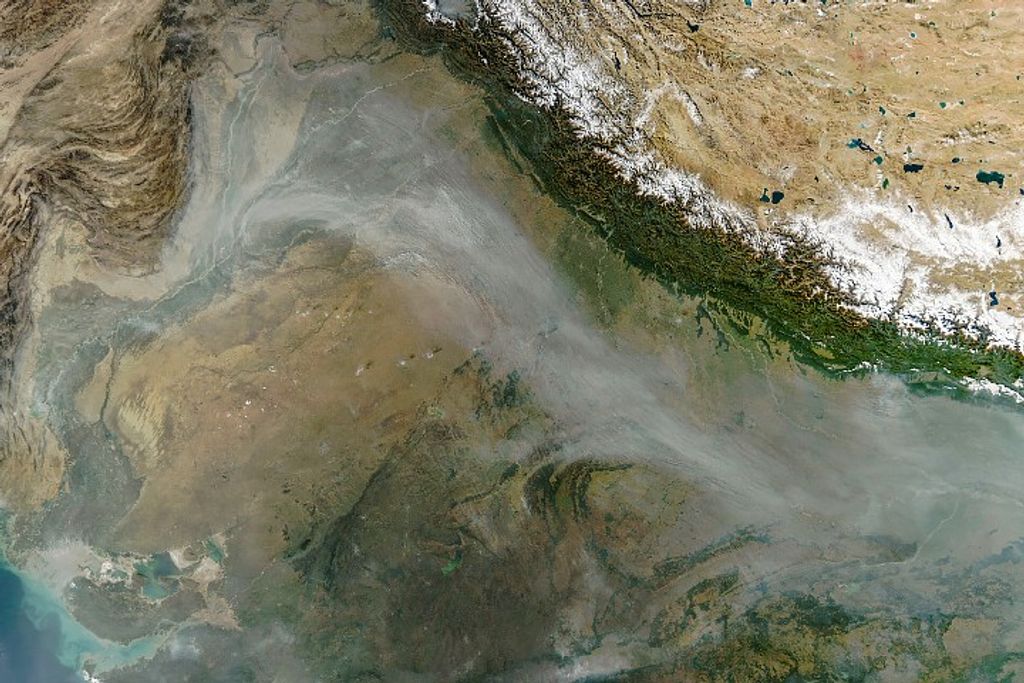1 min read
Jupiter (Nov. 2022 and Jan. 2023)

[left]—The forecast for Jupiter is stormy weather at low northern latitudes. A prominent string of alternating storms is visible, forming a "vortex street" as some planetary astronomers call it. This is a wave pattern of nested anticyclones and cyclones, locked together like in a machine with alternating gears moving clockwise and counterclockwise. If the storms get close enough to each other, in the very unlikely event of a merger, they could build an even larger storm, potentially rivaling the current size of the Great Red Spot. The staggered pattern of anticyclones and cyclones prevents individual storms from merging. Activity is also seen interior to these storms; in the 1990s Hubble didn't see any cyclones or anticyclones with built-in thunderstorms, but these storms have sprung up the last decade. Strong color differences indicate that Hubble is seeing different cloud heights and depths as well.
The orange moon Io photobombs this view of Jupiter's multicolored cloud tops, casting a shadow toward the planet's western limb. Hubble's resolution is so sharp that it can see Io's mottled-orange appearance, related to its numerous active volcanoes. These volcanoes were first discovered when the Voyager 1 spacecraft flew by in 1979. The moon's molten interior is overlaid by a thin crust through which the volcanoes eject material. Sulfur takes on various hues at different temperatures, which is why Io's surface is so colorful. This image was taken on November 12, 2022.
[right]—Jupiter's legendary Great Red Spot takes center stage in this view. Though this vortex is big enough to swallow Earth, it has actually shrunken to the smallest size it has ever been over observation records dating back 150 years. Jupiter's icy moon Ganymede can be seen transiting the giant planet at lower right. Slightly larger than the planet Mercury, Ganymede is the largest moon in the solar system. It is a cratered world with a mainly water-ice surface with apparent glacial flows driven by internal heat. (This image is smaller in size because Jupiter was 81,000 miles farther from Earth when the photo was taken.) This image was taken on January 6, 2023.
For more details, download the Extended Text Description.
About the Object
- DistanceDistanceThe physical distance from Earth to the astronomical object. Distances within our solar system are usually measured in Astronomical Units (AU). Distances between stars are usually measured in light-years. Interstellar distances can also be measured in parsecs.On Nov. 12, 2022 Jupiter was 4.26 AU from Earth (about 396 million miles). On Jan. 06, 2023 Jupiter was 5.07 AU from Earth (about 472 million miles).
About the Data
- Data DescriptionData DescriptionProposal: A description of the observations, their scientific justification, and the links to the data available in the science archive.
Science Team: The astronomers who planned the observations and analyzed the data. "PI" refers to the Principal Investigator.The HST observations include those from program 16790 (A. Simon)
- InstrumentInstrumentThe science instrument used to produce the data.WFC3/UVIS
- Exposure DatesExposure DatesThe date(s) that the telescope made its observations and the total exposure time.12 Nov. 2022, 06 Jan. 2023
- FiltersFiltersThe camera filters that were used in the science observations.F395N, F502N, F631N
- Object NameObject NameA name or catalog number that astronomers use to identify an astronomical object.Jupiter
- Object DescriptionObject DescriptionThe type of astronomical object.Planet
- Release DateMarch 23, 2023
- Science ReleaseHubble Monitors Changing Weather and Seasons at Jupiter and Uranus
- CreditNASA, ESA, STScI, Amy Simon (NASA-GSFC), Michael Wong (UC Berkeley); Image Processing: Joseph DePasquale (STScI)
Downloads

These images are a composite of separate exposures acquired by the WFC3 instrument on the Hubble Space Telescope. Several filters were used to sample medium wavelength ranges. The color results from assigning different hues (colors) to each monochromatic (grayscale) image associated with an individual filter. In this case, the assigned colors are: Blue: F395N, Green: F502N, Red: F631N

Related Images & Videos

Uranus (Nov. 2014 and Nov. 2022)
Planetary oddball Uranus rolls on its side around the Sun as it follows an 84-year orbit, rather than spinning in a more-vertical position as Earth does. Uranus has a weirdly tipped "horizontal" rotation axis angled just eight degrees off the plane of the planet's orbit. One...

Jupiter Compass Image
Two views of the giant gas planet Jupiter appear side-by-side for comparison. At the top, left corner of the left image is the label Jupiter, November 12, 2022, HST WFC3/UVIS. At the left, bottom corner of the left image is a small, horizontal, white line. Over this line is the...

Uranus Compass Image
Two views of the planet Uranus appear side-by-side for comparison. At the top, left corner of the left image is a two-line label. The top line reads Uranus November 9, 2014. The bottoms line reads HST WFC3/UVIS. At the top, left corner of the right image is the label November...
Share
Details
Claire Andreoli
NASA’s Goddard Space Flight Center
Greenbelt, Maryland
claire.andreoli@nasa.gov




























